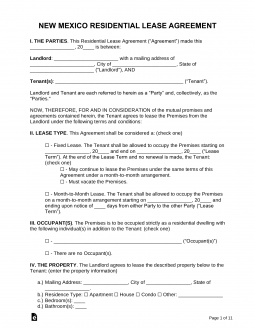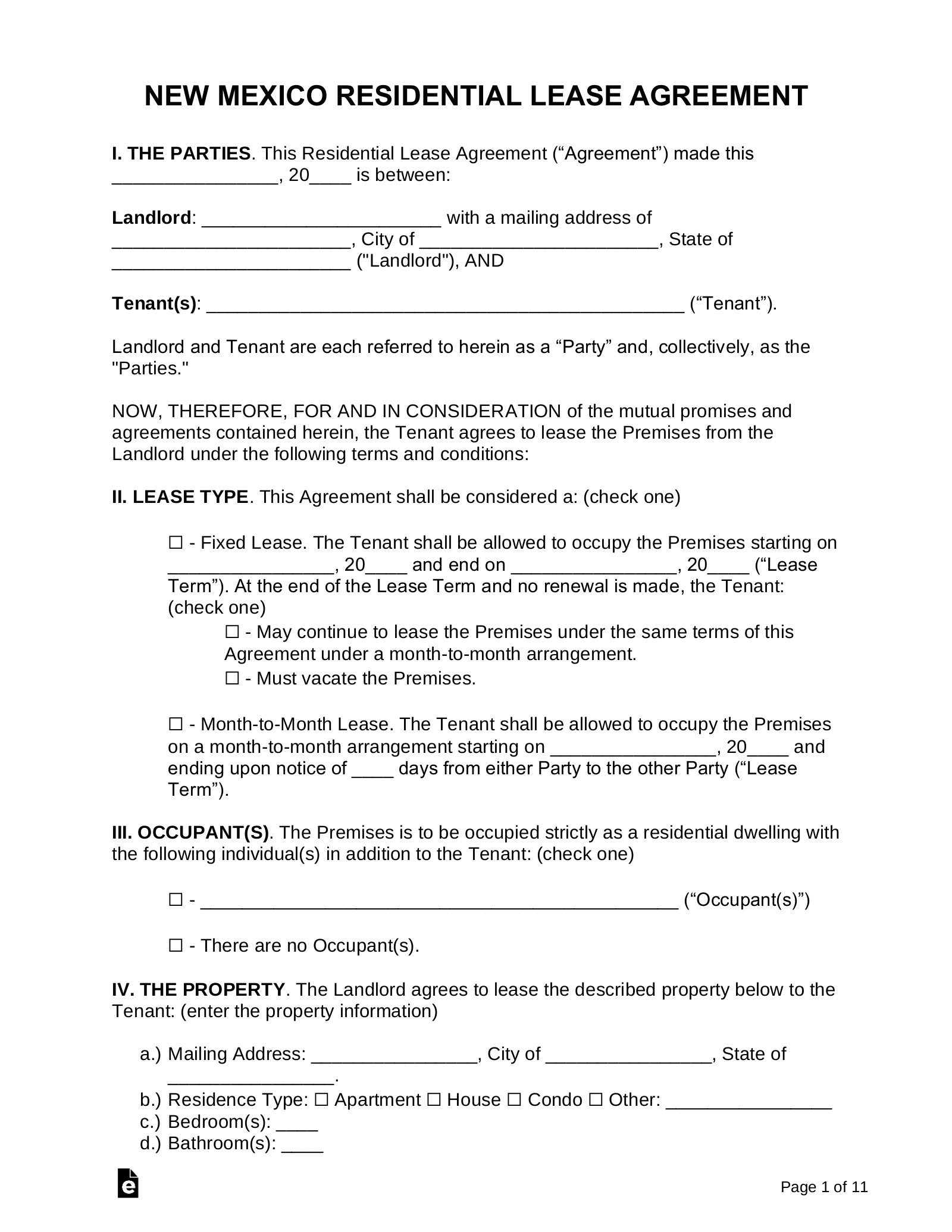Updated February 19, 2024
A New Mexico rental agreement is a legal contract negotiated between a landlord and tenant for the renting of residential and commercial property. The terms, such as the rent amount, timeframe of the lease, and each party’s responsibilities, should be discussed prior to writing an agreement.
Table of Contents |
Agreement Types (6)
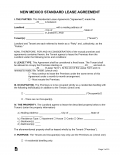 Standard Residential Lease Agreement – The most common type and is a fixed term usually lasting one year. Standard Residential Lease Agreement – The most common type and is a fixed term usually lasting one year.
Download: PDF, MS Word, OpenDocument |
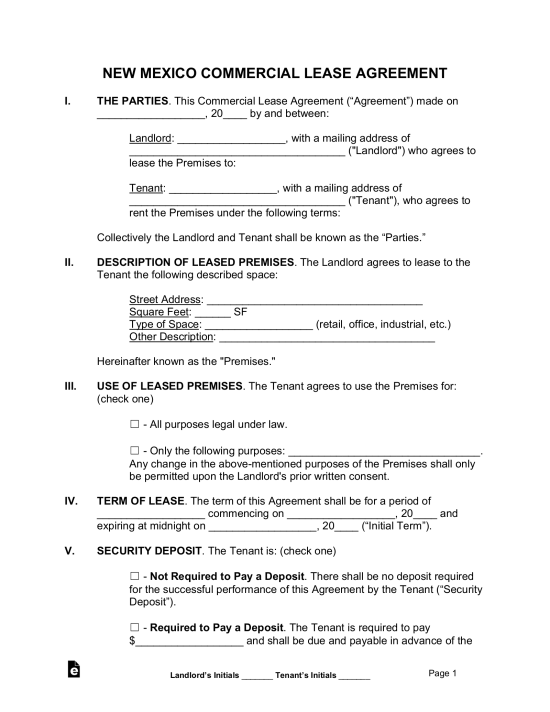 Commercial Lease Agreement – For the use of an office, industrial, or retail use. Commercial Lease Agreement – For the use of an office, industrial, or retail use.
Download: PDF, MS Word, OpenDocument |
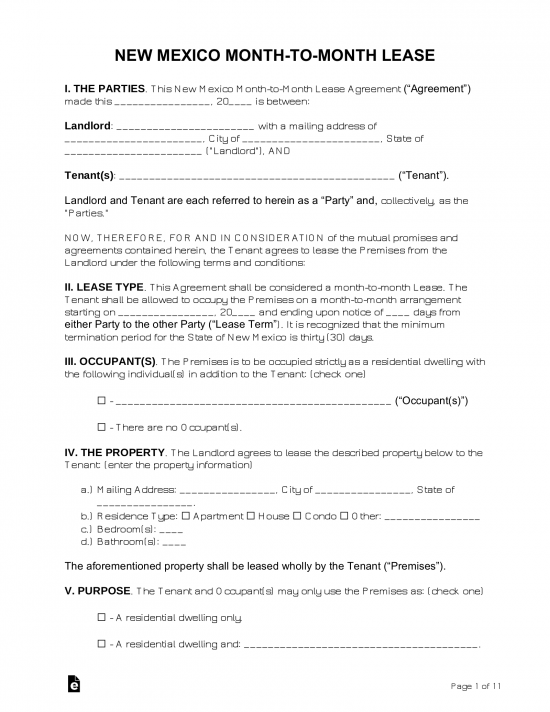 Month-to-Month Lease Agreement – Referred to as a “tenancy at will,” which does not have an ending period and goes on until one of the parties gives at least 30 days’ notice. Month-to-Month Lease Agreement – Referred to as a “tenancy at will,” which does not have an ending period and goes on until one of the parties gives at least 30 days’ notice.
Download: PDF, MS Word, OpenDocument |
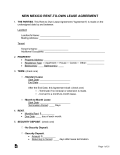 Rent-to-Own Lease Agreement – Standard rental form that allows the tenant to buy the property for an agreed-upon price. Rent-to-Own Lease Agreement – Standard rental form that allows the tenant to buy the property for an agreed-upon price.
Download: PDF |
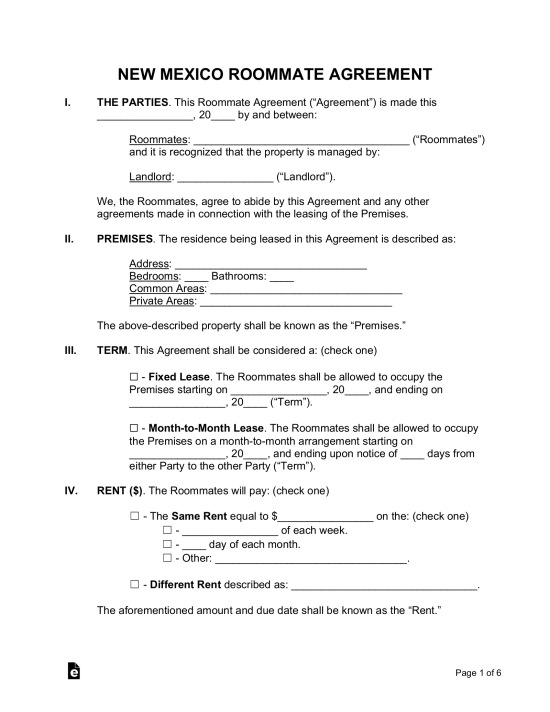 Room Rental (Roommate) Agreement – Between the members of a single residential dwelling in order to establish rules between each other. Room Rental (Roommate) Agreement – Between the members of a single residential dwelling in order to establish rules between each other.
Download: PDF, MS Word, OpenDocument |
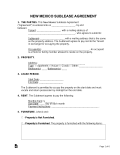 Sublease Agreement – A tenant who decides to rent their space for the remaining term of their residential contract. Sublease Agreement – A tenant who decides to rent their space for the remaining term of their residential contract.
Download: PDF, MS Word, OpenDocument |
Required Disclosures (2)
- Identity – The landlord must disclose to the tenant the identities of all individuals authorized to manage the premises or to act on behalf of the owner.[1]
- Lead-Based Paint Disclosure – If the residence was built before 1978, federal law requires that the landlord inform the tenant of the possible existence of lead-based paint in the unit.
Security Deposits
Maximum Amount – The landlord may request up to one month’s rent for tenancies of less than one year. There is no limit on the amount a landlord can charge as a security deposit for annual rental agreements.[2]
Collecting Interest – If the landlord demands an amount greater than one month’s rent as a security deposit on an annual lease, then they must pay the tenant interest equal to the passbook interest used by savings and loan associations in the state.[3]
Returning – The landlord must return the security deposit, minus any withheld amounts, to the tenant within 30 days of the termination date.[4]
- Itemized List – The landlord must provide the tenant with an itemized list of any deductions from the security deposit retained for nonpayment of rent or utilities, repair work, or other legitimate damages.[4]
When is Rent Due?
Grace Period – Rent is due at the time agreed upon in the rental contract. There is no statutory grace period.[5] If rent is not paid on the due date, the landlord can send the tenant a three-day notice to quit.
Maximum Late Fee – 10% of the monthly rent is the maximum late fee allowed.[6]
NSF Fee – The landlord may charge a fee of up to $20 for a bad check.[7]
Withholding Rent – If the landlord fails to maintain the dwelling in a way that impacts health or safety, the tenant may withhold one-third of the pro-rata daily rent until the condition is remedied or 100% of the rent if the unit is uninhabitable.[8]
Right to Enter (Landlord)
Standard Access – The landlord must give 24 hours’ notice before entering the unit to inspect the premises or perform any maintenance.[9]
Immediate Access – The landlord may enter the unit without giving notice to the tenant in the case of an emergency.[10]
Abandonment
Absence – If the tenant has been absent from the unit for more than seven days without having given notice to the landlord, and if they are delinquent in paying rent, then the landlord can presume that the tenant has abandoned the unit.[11]
Breaking the Lease – If there is a material noncompliance with the rental agreement by the landlord, then the tenant may terminate the lease seven days after having given the landlord notice of the breach.[12]
Tenant’s Utility Shutoff – If the tenant’s failure to keep utilities on the premises impacts the health and safety of those on the property, then the landlord can serve a seven-day notice to quit or to restore essential utilities.[13]
Unclaimed Property – The landlord must store any personal property left behind by the tenant for at least 14 days, after which time they may dispose of it.[14] If the tenant abandoned the dwelling, the landlord must store their personal property for at least 30 days and give written notice to the tenant of their intent to dispose of it.[15]

